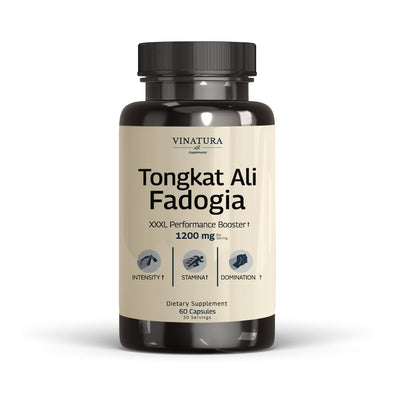
Shilajit Vs. Kratom: A Detail Comparison of Natural Remedies
The market is awash with natural health supplements offering a range of benefits. This article focuses primarily on two compounds, Shilajit and Kratom, renowned for their energy-enhancing properties, natural origins, and consumer popularity. However, what distinguishes them, or is one superior to the other? Let's explore.
Before exploring further, please read the disclaimer located at the end of this webpage.
What Is Kratom?
Kratom (Mitragyna speciosa Korth., Rubiaceae) is an herb originating from Southeast Asia, containing the chemical mitragynine, which acts similarly to opium or morphine [1].
For centuries, Kratom has been utilized as a gentle stimulant and as a remedy for various ailments such as hypertension, cough, fever, and diarrhea.
Despite its widespread use in traditional medicine, some of Kratom's components, such as its alkaloids and metabolites, have not been highly regarded for safety.
However, at low doses, oral supplementation of Kratom can enhance productivity and stamina, suitable for manual laborers working under harsh conditions [2].
What Does Kratom Do for Health?
To compare Shilajit vs Kratom effectively, one should consider the health benefits each herb offers, starting with Kratom:
- Utilized as a pain reducer, soothing and healing pain [3][5].
- Counteracts anxiety and depression in individuals [4][6].
- Prevents addiction disorders, especially opioid disorders [5].
- Boosts energy and performance [19].
- Treats fever, cough, and skin infections [20].
What Is Shilajit?

Shilajit is a sticky, black substance primarily found in the rocks of the Himalayas. It forms over centuries from the slow decomposition of plants, further broken down by bacteria. This process enriches shilajit with organic compounds and minerals.
Shilajit, a natural substance, has a long history in traditional medicine for containing over 80 different minerals, including fulvic acid, humic acid, and microelements such as iron, magnesium, and calcium, and is used for its anti-inflammatory properties, energy, and cognitive function improvements…
What Does Shilajit Do for Health?
Similarly, to make an accurate comparison between Shilajit vs Kratom, understanding the health benefits of Shilajit is essential:
- Anti-oxidative properties, preventing cancer, and extending lifespan due to its content of over 60% fulvic acid compounds [7].
- Ulcer-resistant properties [8].
- Enhances cognition and memory [9][10][11].
- Treats diabetes [12].
- Fights against anxiety and depression [13].
- Anti-allergic and immune system regulation [14][15][16].
- High-altitude protection [17].
- Boosts physical and mental energy [18].
Shilajit vs Kratom: A Detailed Comparison
Given the above overview of each substance's characteristics, you may now have some understanding of the differences between Shilajit vs Kratom. To further this comparison, the information below will assist you.
Do Shilajit and Kratom Have Any Similarities?
Kratom and Shilajit share some similarities.
Notably, users report that both substances have an unpleasant taste upon consumption. Shilajit tastes bituminous, posing a challenge for first-time users. At the same time, Kratom is bitter but not so much as to halt its use altogether.
Next, both Kratom and Shilajit provide a significant energy boost to the body, improving work quality and overall performance. Among them, Red Vein Kratom is regarded as a popular pharmaceutical for its natural energy-enhancing properties.
Besides health benefits, both Shilajit and Kratom pose potential risks to the body and are under ongoing research. Therefore, it's advisable to research thoroughly and consult a specialist to ensure safety before usage.
Finally, Kratom and Shilajit are available in various forms. You can easily purchase them in capsule or powdered form. However, buying Shilajit in its pure form from trusted brands, either as bitumen or resin, is recommended to avoid counterfeit products.
Note that when purchasing raw Shilajit, learning about its processing methods is crucial to prevent bodily harm.
Explore more: Gokshura Vs Shilajit: Can You Take Them Together?
What are the Differences Between Shilajit and Kratom?
This article will now address the remaining comparison aspect, the differences between Shilajit vs Kratom.
The first difference lies in their origins. While Shilajit is mineral-based and forms from mountain rocks, Kratom originates from leaves. Pure Shilajit takes thousands of years to mature fully and be processed for use, whereas Kratom takes about two years to achieve this.
The second difference is in their principal components and benefits. Shilajit contains over 80 minerals, including fulvic acid, humic acid, and trace elements like iron, magnesium, and calcium.
It offers anti-inflammatory and antioxidant properties, cognitive function improvement, and cardiovascular health enhancement. Meanwhile, Kratom comprises alkaloid compounds, including mitragynine and 7-hydroxy mitragynine, with analgesic, antidiarrheal, and energy-boosting effects.
Lastly, the difference in side effects. Shilajit is considered safe and rarely causes side effects when used; however, at high doses, it may lead to allergies and diarrhea.
Kratom, on the other hand, can have more severe side effects, such as nausea, addiction, liver damage, renal failure, memory decline, and even death [1].
The table below summarizes the basic differences between Shilajit vs Kratom:
|
Criteria |
Shilajit |
Kratom |
|
Origin |
From the cliffs of the Himalayan ranges |
From the leaves of trees in Southeast Asia |
|
Formation time |
Thousands of years |
About 2 years |
|
Active compound |
Fulvic acid, humic acid, trace elements such as iron, magnesium, calcium |
Alkaloid compounds like mitragynine and 7-hydroxymitragynine |
|
Benefits |
- Antioxidant properties - Enhanced cognition - Pain relief - Increased overall energy |
- Anxiety and depression relief - Mood improvement - Hormonal balance - Enhanced immune function - Pain relief, anti-inflammatory - Reduced opioid withdrawal symptoms - Enhanced cognition - Increased energy - Prevention of skin infections |
|
Price |
Expensive |
Affordable |
|
Form |
Capsules, powder, and liquid |
Leaves, powders, gums, capsules |
|
Side effect |
Few side effects |
Relatively serious side effects |
|
Availability |
Common |
Common |
|
Ease of use |
Unpleasant taste |
Unpleasant, bitter taste |
|
Dosage |
250 - 500 mg per day |
72,5 - 74,9 mg per day [21] |
Shilajit Vs. Kratom: What Natural Remedies Should You Choose?

Both Shilajit and Kratom are natural supplements used in traditional medicine to treat various conditions. However, these two herbs differ in their origin, components, benefits, side effects, and price as observed in the comparison table above.
Suppose you're seeking a natural way to improve overall health, antioxidant intake, and exercise performance. In that case, Shilajit may be a good option. For those looking for a natural remedy to alleviate pain, improve mood, and boost energy, Kratom might be the priority.
Yet, both have potential side effects that are currently under further investigation. It's important to use them appropriately, tailored to your body's needs, and with advice from professionals to achieve the best consumption effects.
Conclusion
The information above provides a basic comparison between Shilajit vs Kratom. Both compounds offer nutrients that help nourish the body, but inappropriate consumption may lead to undesirable side effects. Before use, it is advisable to research thoroughly and consult a doctor about your health condition.
Related Article:
References
- [1] “Kratom: Uses, Side Effects, Interactions, Dosage, and Warning.” Webmd.com, 2019, www.webmd.com/vitamins/ai/ingredientmono-1513/kratom.
- [2] T. Swogger, Marc , and Kirsten E. Smith. “Understanding Kratom Use: A Guide for Healthcare Providers.” Frontiersin, 2022, www.frontiersin.org/journals/pharmacology/articles/10.3389/fphar.2022.801855/full. Accessed 14 Apr. 2024.
- [3] Summary of Assessments, Findings and Recommendations of the 44th World Health Organization’s (WHO) Expert Committee on Drug Dependence (ECDD), 11–15 October 2021. 1 Dec. 2021, www.unodc.org/documents/commissions/CND/CND_Sessions/CND_64Reconvened/ECN72021_CRP12_V2108992.pdf. Accessed 14 Apr. 2024.
- [5] Garcia-Romeu, Albert, et al. “Kratom (Mitragyna Speciosa): User Demographics, Use Patterns, and Implications for the Opioid Epidemic.” Drug and Alcohol Dependence, vol. 208, Mar. 2020, p. 107849, https://doi.org/10.1016/j.drugalcdep.2020.107849. Accessed 5 May 2020.
- [6] Swogger, Marc T., and Zach Walsh. “Kratom Use and Mental Health: A Systematic Review.” Drug and Alcohol Dependence, vol. 183, Feb. 2018, pp. 134–140, https://doi.org/10.1016/j.drugalcdep.2017.10.012.
- [7] “Shilajit: A Natural Phytocomplex with Potential Procognitive Activity.” Www.hindawi.com, www.hindawi.com/journals/ijad/2012/674142/.
- [8] S. Ghosal, S. K. Singh, Y. Kumar et al., “Shilajit. 3. Antiulcerogenic of fulvic acids and 4-methoxy-6-carbomethoxybiphenyl isolated from shilaji,” Phytotherapy Research, vol. 2, no. 4, pp. 187–191, 1988.
- [9] A. Cornejo, J. M. Jiménez, L. Caballero, F. Melo, and R. B. Maccioni, “Fulvic acid inhibits aggregation and promotes disassembly of tau fibrils associated with alzheimer's disease,” Journal of Alzheimer's Disease, vol. 27, no. 1, pp. 143–153, 2011.
- [10] I. A. Schepetkin, G. Xie, M. A. Jutila, and M. T. Quinn, “Complement-fixing activity of fulvic acid from shilajit and other natural sources,” Phytotherapy Research, vol. 23, no. 3, pp. 373–384, 2009.
- [11] A. K. Jaiswal and S. K. Bhattacharya, “Effects of shilajit on memory, anxiety and brain monoamines in rats,” Indian Journal of Pharmacology, vol. 24, pp. 12–17, 1992.
Author

Product Disclaimer
Including an ingredient or study does not evaluate, endorse, or recommend any Vinatura product or any third-party product. Some ingredients discussed may not be used in any Vinatura product.
The content of the articles has not been evaluated by the Food and Drug Administration (FDA) and is not intended to promote or endorse any specific product. Any products sold on this website are not intended to diagnose, treat, cure, or prevent any disease.
Opinions and Endorsements
Any claims, statements, or opinions expressed in the articles are those of the author(s) and do not necessarily reflect the views or opinions of the manufacturers of the dietary supplement products. The products sold on this website are separate from the content of the articles and are not directly endorsed or associated with the information presented here.
Liability Disclaimer
The author(s) of the articles, website, and manufacturers of the dietary supplement products do not assume any liability for any potential consequences arising from the use of the information provided in the articles. Ingredient effects, dosages, and safety vary by individual, formulation, and context; some ingredients interact with medications or may be unsuitable during pregnancy or lactation. It is recommended that individuals consult with a qualified healthcare professional before making any dietary or lifestyle changes, including the use of dietary supplements.
Product Usage
Please refer to the product labels and packaging for specific usage instructions and guidelines for the dietary supplement products sold on this website.
Customer Support
For any concerns or questions regarding the dietary supplement products, please contact our customer support team, who will be more than happy to assist you.





Leave a Comment
Be the first to comment.
What do you think?